Level Switches
Level switches, also sometimes called level control switches, are measuring utilities that indicate material levels in storage enclosures or transmission equipment; in some cases they can be used both for level measurement and level control. A level switch indicates these levels by means of an electrical switching action. Some of these devices could also be classified as level sensors or level indicators; those terms are restricted to systems that measure levels but do not control them.
Quick links to Level Switches Information
The History of Level Switches
The history of level switches is tied up with the history of fluid dynamics, which is the study of fluids, how they move and the forces that move them. Fluid dynamics have been in play since prehistory. The first person to write about them, as far as we know, was Archimedes, a polymath of antiquitous Greece. He developed the law of buoyancy, later known as Archimedes’ principle, in his 250 BC work, On Floating Bodies. Archimedes’ principle maintains that a body immersed in a fluid will encounter buoyant forces equal to the weight of the fluid it displaces. In addition, each fluid mass particle, when in equilibrium, experiences pressure from every direction equally.
Islamicate scientists and engineers were early innovators of level control technology. In the 9th century, the Banu Musa brothers described level control mechanisms including a float chamber and a float valve. During the middle ages, Islamicate scientists such as Al-Khazini and Abu Rayhan Biruni began studying fluid mechanics using scientific principles. Through their studies, they learned how to calculate fluid and float weights. Biruni, the older of the two, learned how to find the ratio of the weight of substances in the air to the weight of displaced water (conical measurement). He all learned and wrote down weight differences between various liquids, like saline water and freshwater, and cold water and hot water. Through his studies, Biruni discovered overall the correlation between object gravity and the water volume it displaces. Al-Khazini invented hydrostatic balance, which he wrote about in his 1121 AD book, The Book of the Balance of Wisdom.
During the 1800s, engineers began applying for level switch patents. One example of an early level switch, as described in the patent, was a magnetic float that caused needles to move when the liquid level changed. As machines became more advanced, so did level switches. Today, level switches are safer, more reliable and more versatile than ever.
Applications of Level Switches
Level switches have applications in a wide range of industries. Some examples of these applications include: pharmaceutical ingredients processing (for the measurement of bulk quantities of drug ingredients), food and beverage processing (for the monitoring of liquid and powder food item levels during production and packaging), HVAC systems design (for control and level monitoring of oil or refrigerant levels in heating and cooling systems; chambered level switches are often used in boilers), industrial manufacturing (to control potentially hazardous chemicals required in various processing applications), and municipal or industrial water treatment (for the monitoring of wastewater levels).
Advantages of Level Switches
One major advantage of the level switch is its simplicity. Many types have few or no mechanical moving parts. This means that they are not only easy to use and control, but they are also difficult to break. Even if they malfunction, they are easy to fix. Generally speaking, level switches are also safe and reliable. Another advantage is the fact that they are easy to customize.
Level Switch Design
- Materials Used in Level Switches
- For construction, level switch manufacturers commonly use materials such as stainless steel brass and various types of plastics. The two most common plastic materials used include polypropylene and polysulfone, which are available in different colors, and which are good choices for acidic conditions, such as in electroplating and metal cleaning. They are also useful for lower-temperature food processing applications and for general-purpose applications in commercial or consumer appliances and equipment. Brass sensors and switches can be used in petroleum-based liquids; they can be installed in storage tanks of vehicles, generators, and transmission and hydraulic systems as well as in lubrication, recovery, refining and fuel processing equipment.
- Considerations and Customization in Level Switches
- The basic construction of level switches includes a switching mechanism, a tube and a couple of areas of connection. However, manufacturers vary the design varies based on: the desired application, what materials the switch is going to be used to monitor, the size of the container and other considerations. Manufacturers can vary designs from simple to complex and can design them to be triggered by different things, such as pressure, temperature or buoyancy. Additional features of level switch devices that suppliers may add include: thermal sensors, vibrating sensors and optical sensors, which they can modify to recognize specific substances or to reveal when a certain viscosity, density, opacity or thermal conductivity condition is reached. Level switch manufacturers can also cater to specific applications.
- Switch Features and Configurations
- Level switch configurations can be quite diverse. In the case of the simplest liquid level switches, the position of a float or buoy is influenced by the level of the materials the float is intended to measure. If the level of the material rises enough, it will cause the float to rise as well. When the float reaches a certain point, it causes an electrical circuit within the level switch to become closed, sending a signal to whatever indicators or control equipment to which the switch may be attached. A similar principle of operation applies also to solid level switches.
- Spinning rotary level switches, which involve paddles or blades that rotate around an axis, are used to measure the levels of granular solids. Such switches can be placed at different elevations within a storage enclosure. When the spinning of a rotary level switch is interrupted by the presence of a solid, that interruption indicates to control equipment that the level has reached whatever elevation at which the switch has been placed.
- Level switch function becomes more complicated from there; it can involve the transmission and reflection of ultrasonic waves, the projection of infrared beams and the transmission of radio waves. Correctly pairing a level switch variety with its application results in an effective and accurate materials measurement system.
Level Switch Images, Diagrams and Visual Concepts
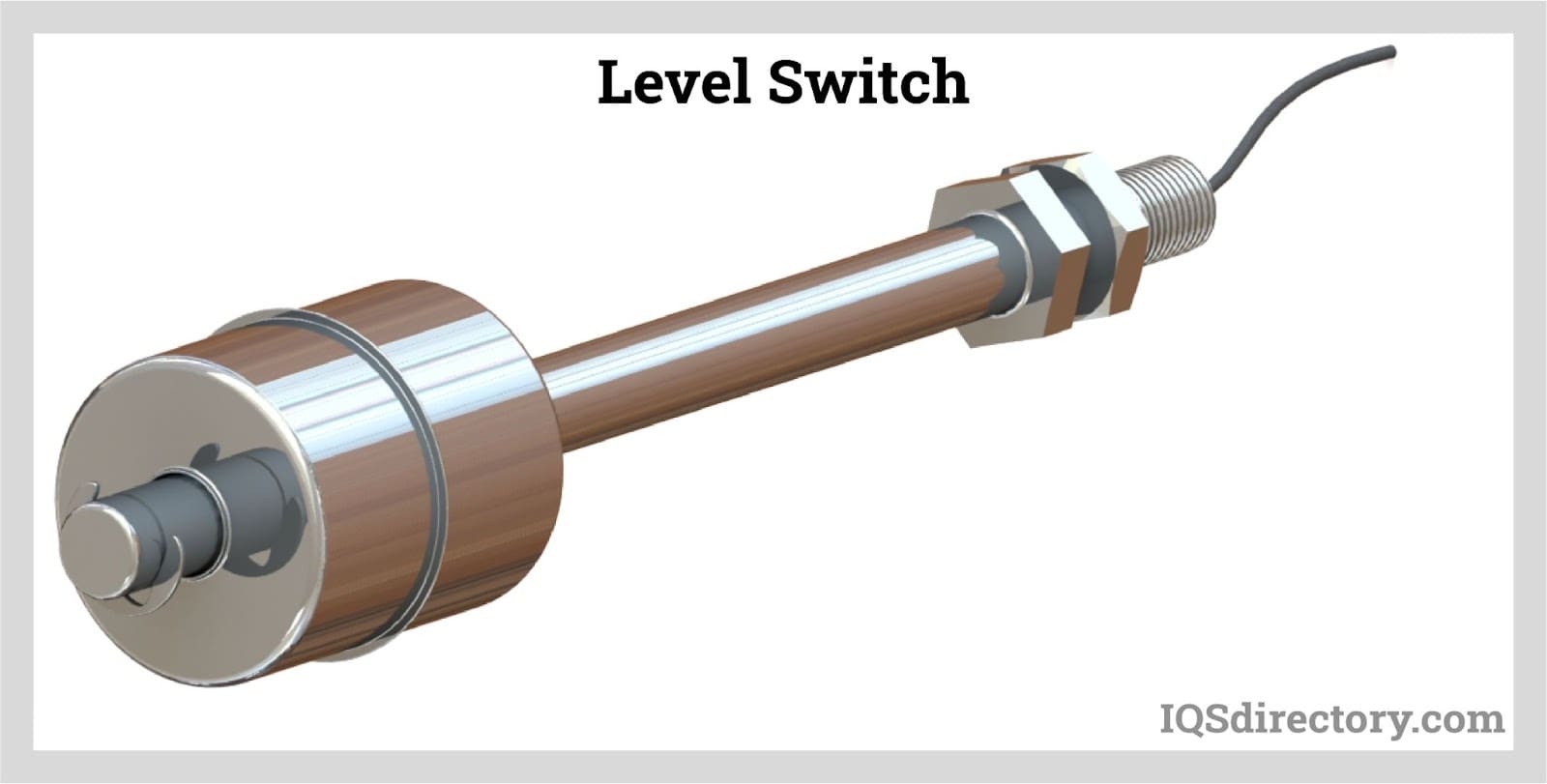 Level switch, an electrical or mechanical method for measuring the level of a liquid, powder, or granule material by activating an alarm if the material level passes a certain height or depth.
Level switch, an electrical or mechanical method for measuring the level of a liquid, powder, or granule material by activating an alarm if the material level passes a certain height or depth.
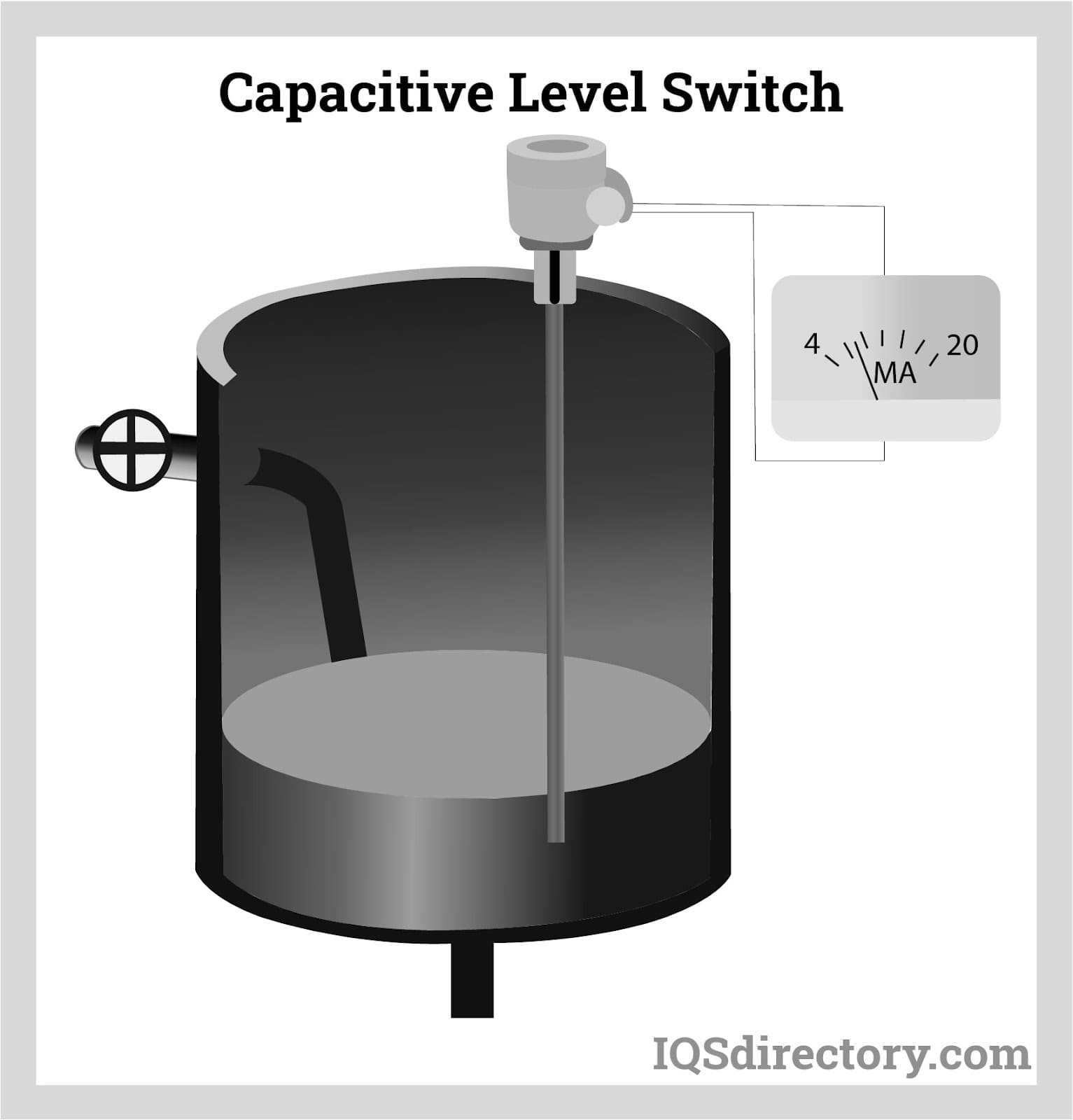 Capacitive level switches are designed for measuring corrosive liquids, high temperatures, and liquid levels in sealed containers.
Capacitive level switches are designed for measuring corrosive liquids, high temperatures, and liquid levels in sealed containers.
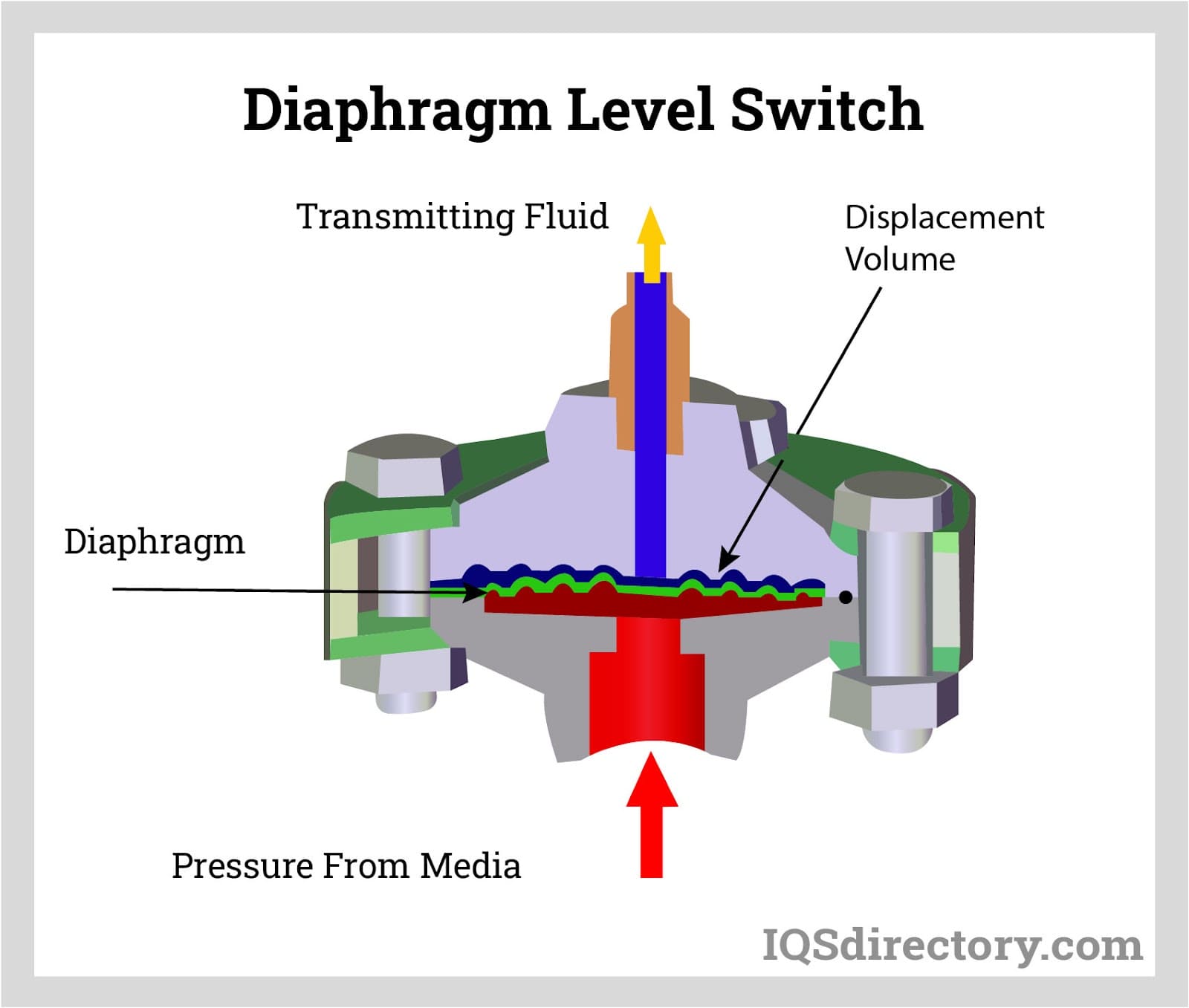 Diaphragm level switch measures pressure changes caused by the increase or decrease of the air pressure.
Diaphragm level switch measures pressure changes caused by the increase or decrease of the air pressure.
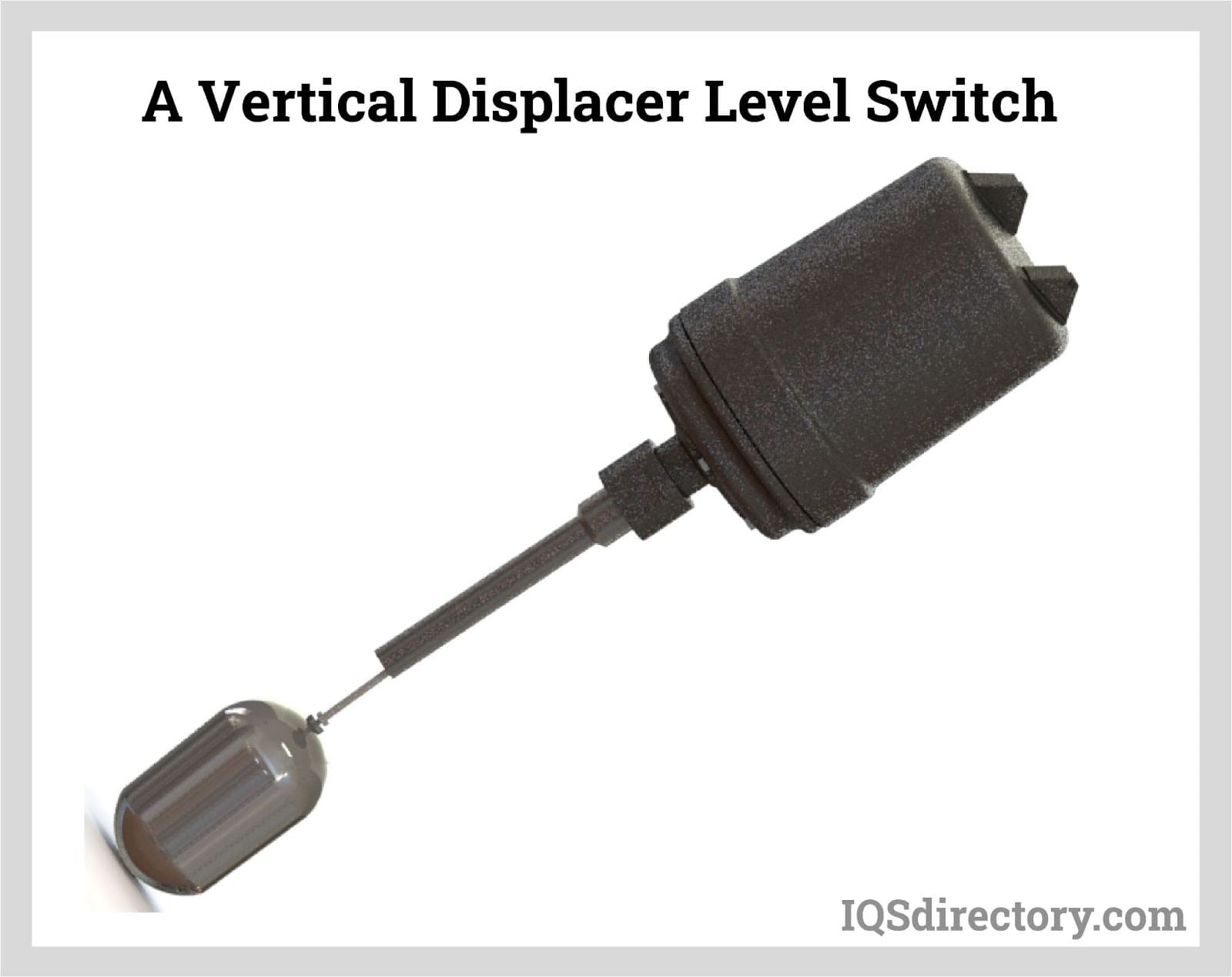 Displacer level switches are designed to work under high temperatures and pressure.
Displacer level switches are designed to work under high temperatures and pressure.
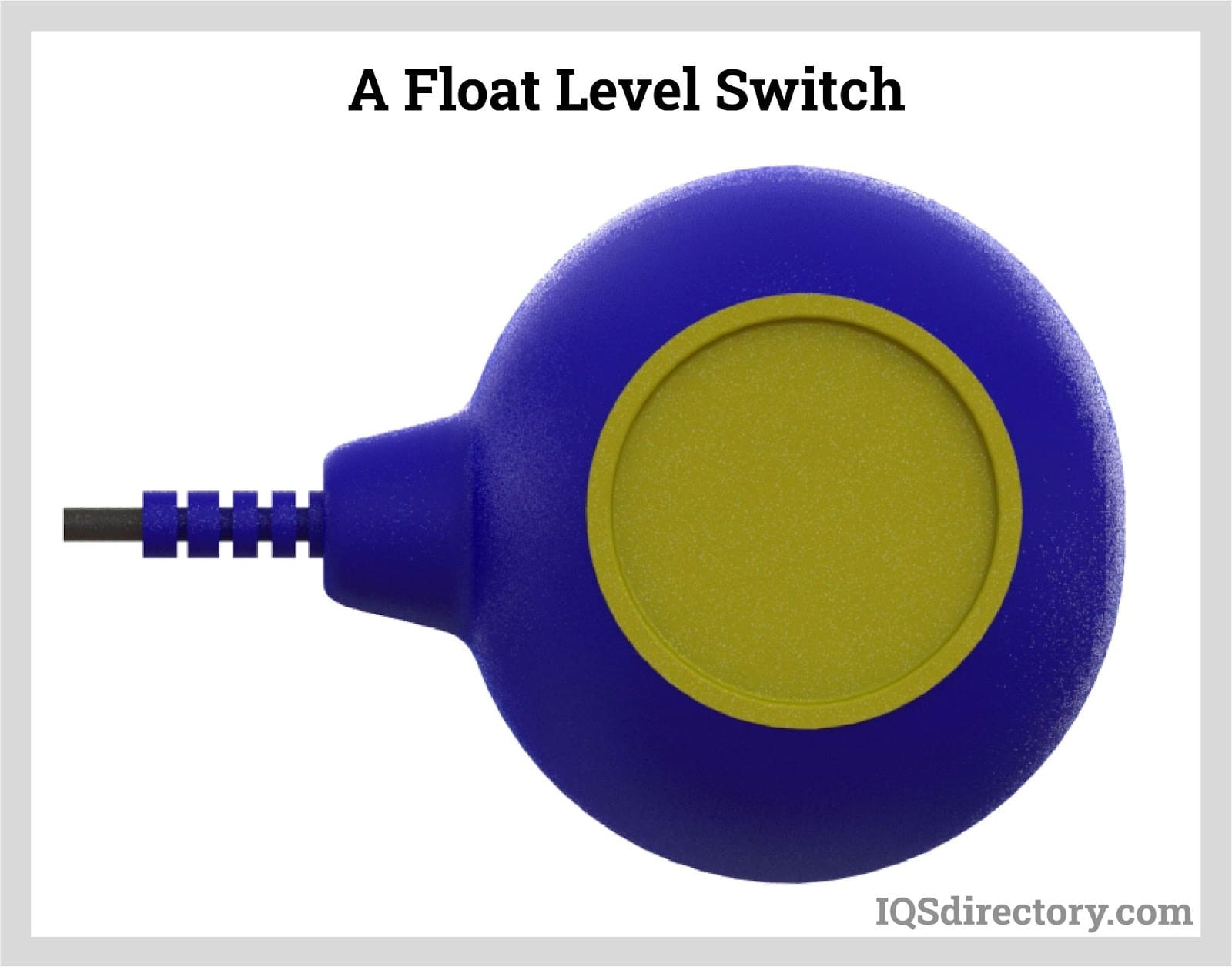 Float level switch, a mechanical switch that floats on the surface of a media.
Float level switch, a mechanical switch that floats on the surface of a media.
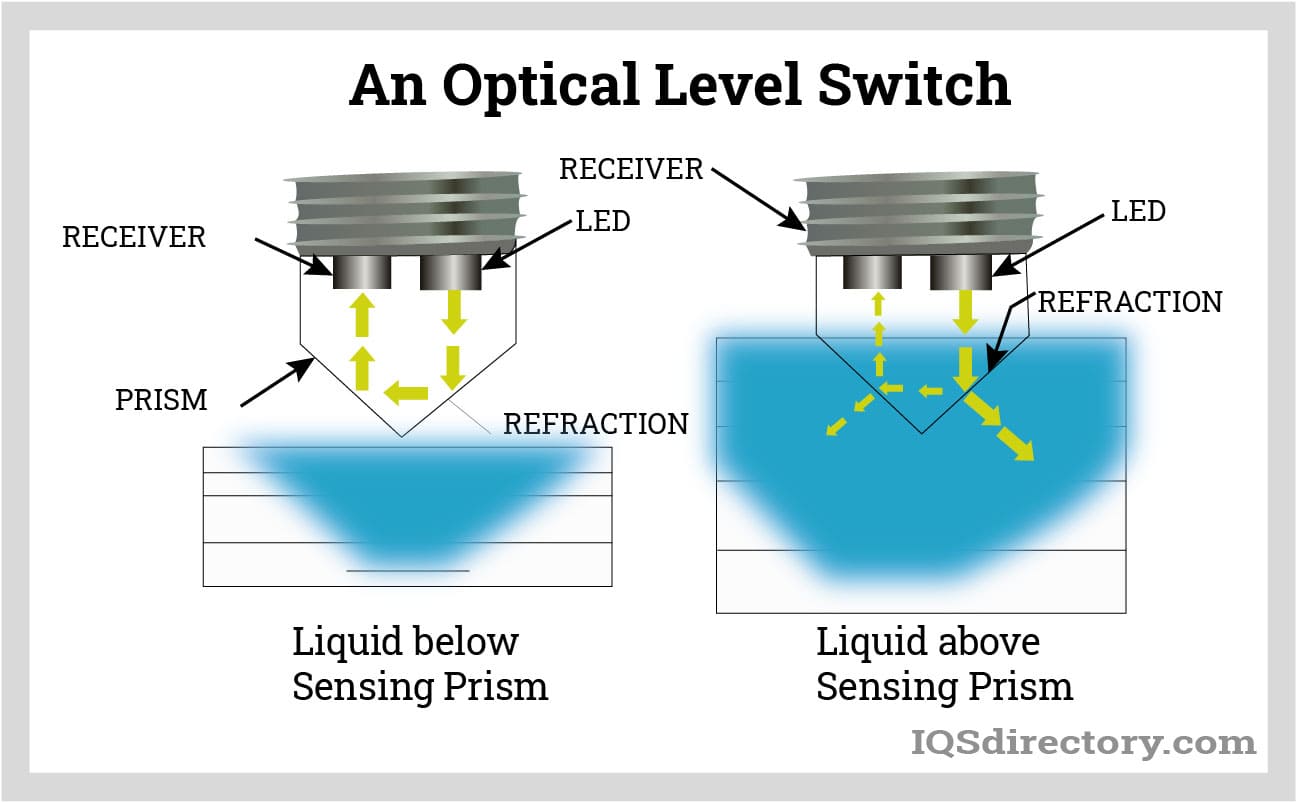 Optical level switches uses a level sensor and light receiver to sense the changes in the liquid level.
Optical level switches uses a level sensor and light receiver to sense the changes in the liquid level.
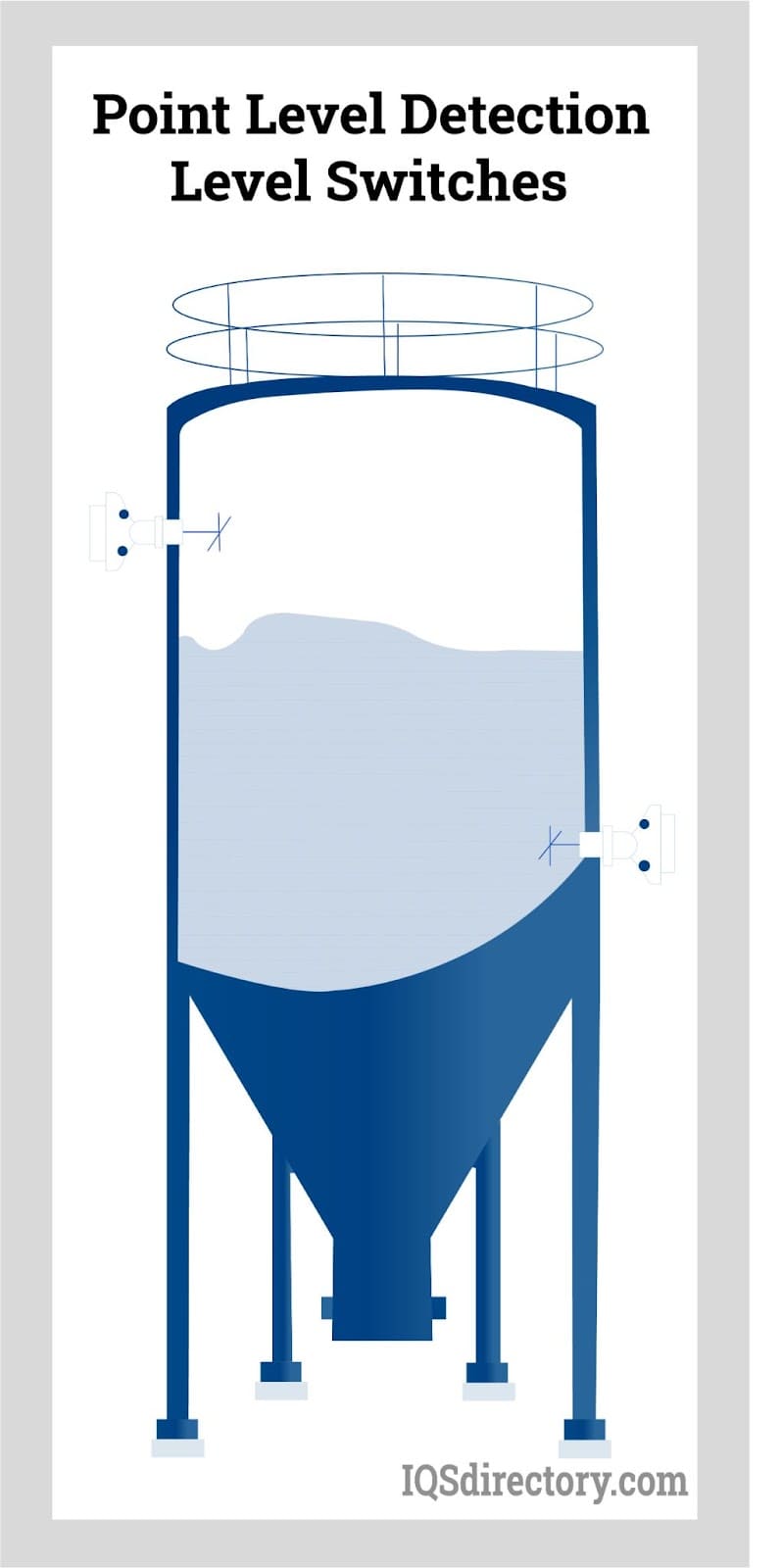 Point level detection switiches are programmed with a predefined level and is activated when the level is reached.
Point level detection switiches are programmed with a predefined level and is activated when the level is reached.
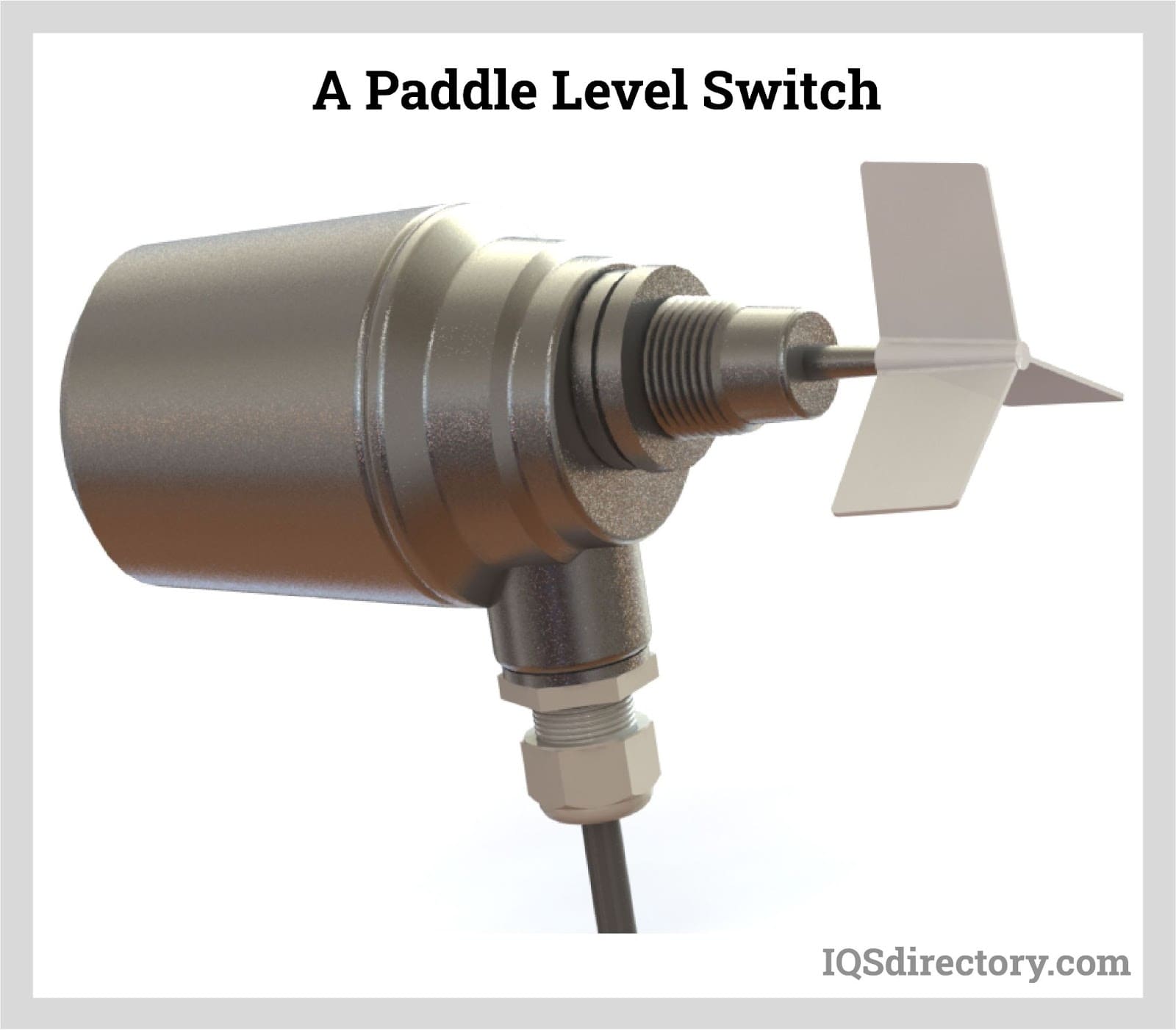 Paddle level switch have an electric motor that slowly rotates a metal paddle when the material reaches a certain level.
Paddle level switch have an electric motor that slowly rotates a metal paddle when the material reaches a certain level.
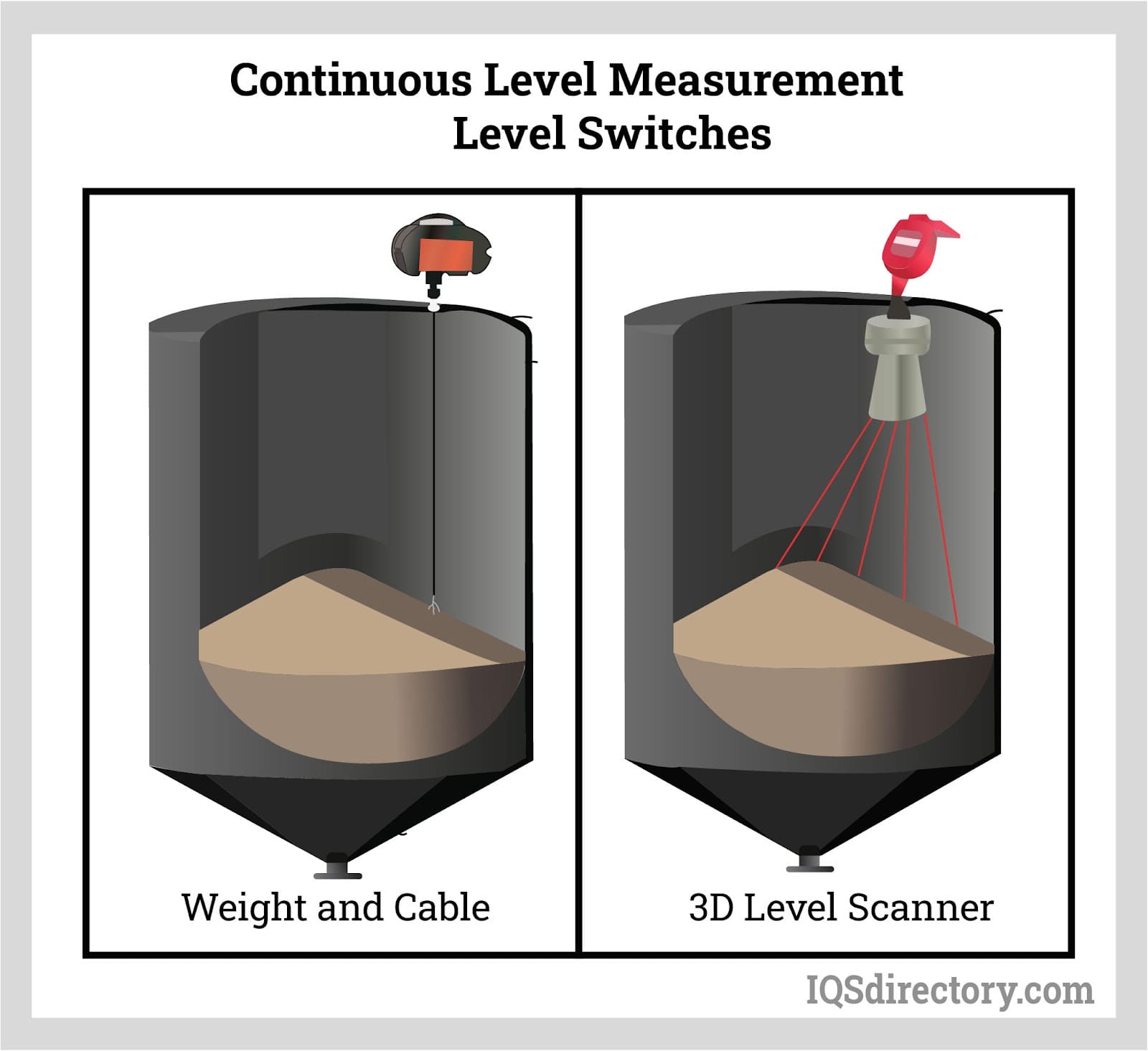 Continuous level measurement level switches have two different methods for installation being horizontal and vertical.
Continuous level measurement level switches have two different methods for installation being horizontal and vertical.
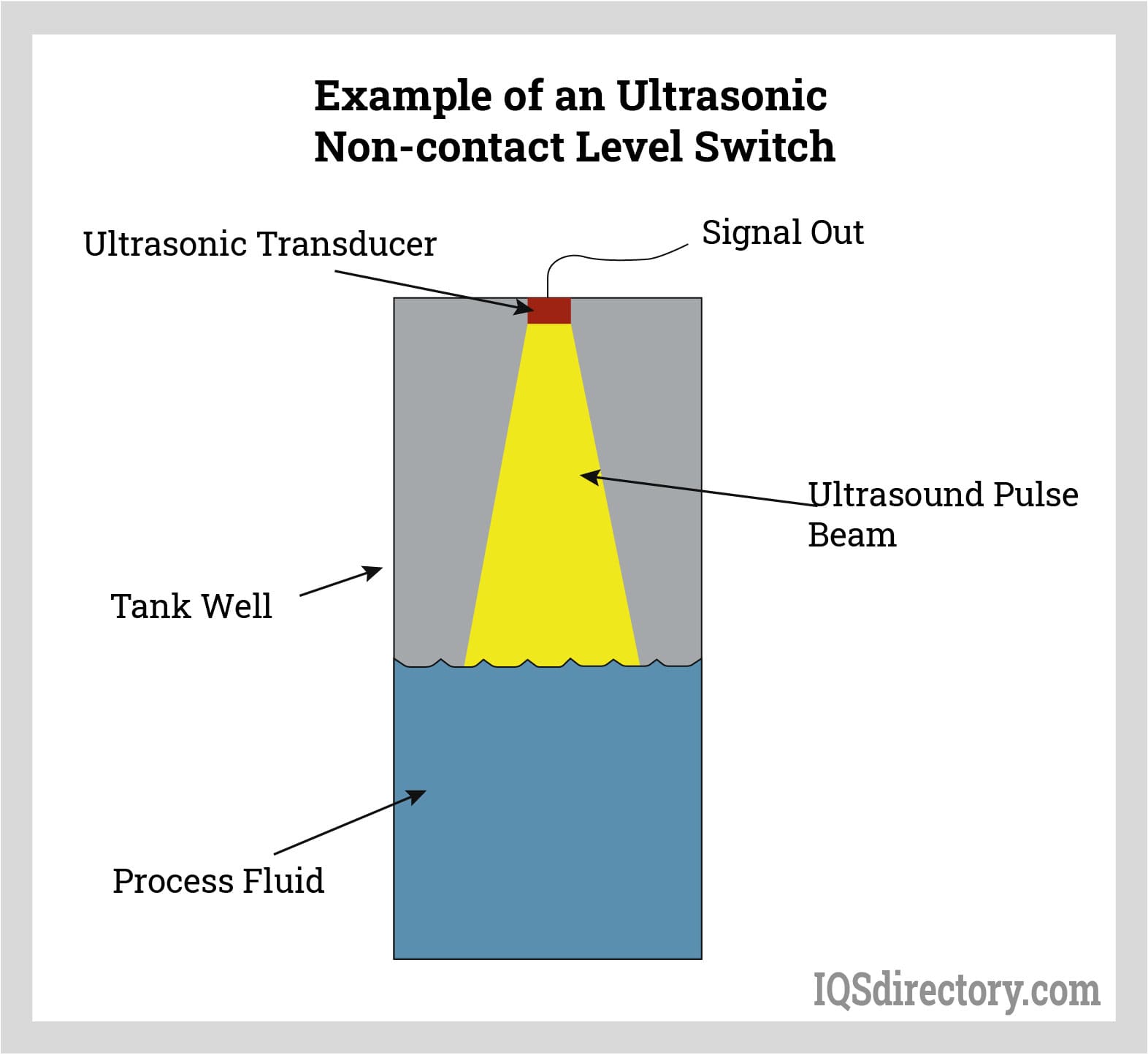 Non-contact level switches measure the time it takes for waves to travel from the transducer to the media.
Non-contact level switches measure the time it takes for waves to travel from the transducer to the media.
Level Switch Types
While there is a diverse range of devices that fall under the heading of level switches, some are more commonly used for industrial applications than others. Some of these more popular level switch types include: capacitance level sensors, chambered level switches, displacer level switches, float level switches, optical level switches and ultrasonic level sensors.
- Mechanical Level Switches
- Come into direct contact with the materials they measure and can be used as both solid and liquid level switches. Their designs offer: versatility and rugged, industrial constructions. They rely on buoyancy principles and may be made of: floats or displacers, spring mechanisms, attraction sleeves, optional chambers or magnet fields that activate switching mechanisms. Examples of common mechanical level switches include: float level switches, displacer level switches and rotary tank level indicators.
- Non-mechanical Level Switches
- Do not come in direct contact with the materials they measure. Examples of non-mechanical level switches include: capacitance level sensors, ultrasonic level sensors and optical level switches.
- Capacitive Level Sensors
- Able to channel or collect a charge of electricity. They function to indicate the presence of materials, particularly as they reach a particular level. Capacitance level sensors can be used to measure the level of materials such as: aqueous and organic liquids, solids and slurries.
- Chambered Level Switches
- Enclosed in a casing, also known as as a chamber, which surrounds the switch mechanism or sensor. Chambers can be flanged or sealed to offer protection or hermetic air-tightness. Although they are used primarily to monitor the amount of liquids and various other materials in containers, chambered level switches can be used to control the flow of materials into and out of containers as well.
- Displacer Level Switch Devices
- Monitor and measure changes in buoyancy force placed on a weight (displacer) heavier than the liquid. They do so by allowing for adjustments to the level of measured materials. Through a spring mechanism, the suspended weight is attached to an attraction sleeve that moves into or out of a magnet field, thus activating or deactivating the switch.
- Electric Level Switches
- Contain open or closed contacts that indicate the presence or absence of liquid.
- Electromechanical Level Switches
- Work with a combination of electric and mechanical parts.
- Float Level Switches
- Mechanisms like rods that float in a liquid. They rise until they activate a pump, an indicator, an alarm or other device. Common float switches include mercury switches enclosed in hinged floats, and suspended “bobbers” attached to attraction sleeves that actuate a magnet field or a more complex sensor construction.
- Float Sensors
- Floating liquid level sensors that do nothing but sense changes.
- Hydrostatic Level Switches
- Sensitive to the static, or stationary, water pressure acting on them.
- Level Control Switches
- Used specifically for material low control, ensuring that levels remain within a specific, designated range.
- Level Indicators
- Measurement devices that determine the amount of material that is in a container.
- Level Sensors
- Measurement devices used to determine the level of materials such as liquids, powders, slurries and granular materials.
- Liquid Level Switch
- Monitor the amount of fluid in a vessel. Ultra-low liquid level switches are available to detect very low levels for early indication of a liquid presence and effective use of expensive liquids.
- Microwave Level Switches
- Made up of two separate parts, a level transmitter and a level receiver. The transmitter emits a burst of energy at approximately 200 times a second toward the receiver; a substance interruption of the microwave between the two devices is the trigger.
- Multi-Point Switches
- Can be engineered to provide a number of actuation points.
- Optical Level Switches
- Cost-effective, compact, quickly installable options that contain no moving parts but use LEDs, which transmit infrared light. When a translucent liquid meets the point where the light contacts the prism, the light is reflected into the water and does not allow the photo transistor to energize.
- Pneumatic Level Switches
- Air-pressure activated through valves and amplifiers.
- Pressure Sensors
- Sense a change in liquid pressure.
- Proximity Switches
- Activate without physical touch. They use sensing fields that tell them to activate when a target is within a certain range, or proximity, of them.
- Thermal Level Switches
- Include temperature sensors that provide activation when a heat change occurs as the liquid surrounds them. Some can sense the difference between the temperatures of the air space and the liquid.
- Tilt Switches
- Switches that are triggered when they are tilted at an angle.
- Two-Stage Level Switch
- Designed with a flood-preventing capability. If liquid reaches the second stage, the switch will turn the pump off and/or sound an alarm.
- Ultrasonic Level Sensors
- Utilize high-frequency (above the audible level) pulse wave technology.
- Vibrating Level Switches
- Can come with reed, probe or tuning fork sensors, which all have similar constructions of a driver coil that vibrates a paddle. The switch detects a dampening of the vibration when the sensor is surrounded by a substance.
Level Switch Standards and Specifications
Level switch standard requirements depend on your industry and application. For example, if working in the food industry, your switches must be FDA approved. If working in the military, your switches must have Mil-Spec certification. To find out the standard certifications you should seek, talk to your industry leaders.
Switch Purchase Considerations
If you are on the lookout for level switches, it’s best if you work with an experienced level switch manufacturer, such as those listed on this page. With the right professional, you will be able to receive sensors and switches that are perfect for your application and your bank account. Take some time now to browse the services and products of those manufacturers we have listed on this page. Pick three or four to whom you’d like to speak directly, then reach out for an in-depth conversation. Don’t forget to discuss your standard requirements, budget, timeline and delivery preferences. After you’ve spoken with each of them, decide which one is right for you, and get started on your project.
Accessories for Level Switches
Common level switch accessories include: alarms, remote gauges, float balls, float rods, pressure switch mounting brackets, counter flanges, shut off valves, etc.
Level Switch Terms
- Aperture
- The space between contiguous parallel wires, expressed in millimeters.
- Buoyancy
- An object’s upward force produced by the fluid in which it is fully or partially submerged.
- Mercury Switch
- A sealed glass tube containing a minimal amount of liquid mercury and two unconnected electrodes that produce electricity flow when the tube is moved past a certain angle so that the liquid metal pools in between the electrodes, making a complete circuit. Once back in the original position, the current stops instantly.
- Opacity
- The extent to which something is optically non-transmissive; opacity is the opposite of transparency.
- Polypropylene or Polypropene (PP)
- A thermoplastic polymer that is rugged and unusually resistant to many chemical solvents, bases and acids.
- Polysulfone or PSU
- A polymer thermoplastic material that offers toughness, rigidity, high-strength and transparency, while also maintaining its characteristics between negative 100°C and positive 150°C.
- Sluice
- A water channel with a gate used to regulate levels and flow rates in rivers, canals and wastewater treatment plants, and to retrieve minerals during the mining process.
- Viscosity
- The thickness of a liquid, or its resistance to flow.